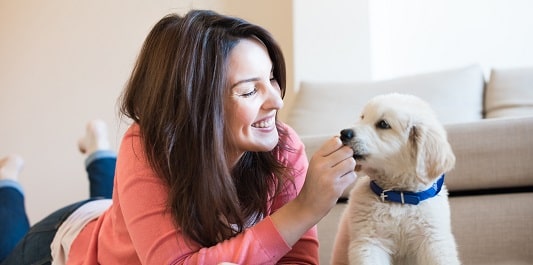A puppy screaming in their crate for hours is likely in distress or craving attention. Puppies may scream in their crates if they’ve been left inside too long, aren’t properly crate trained, or need something. This could be food, exercise, or a potty break.
Leaving a puppy screaming in their crate teaches them that they can’t expect you to help them when they’re upset. Your puppy may eventually stop crying, but only because they feel helpless.
Instead, I recommend a positive crate training method where you first take care of all of your puppies needs, then slowly accommodate them to being crated.
Never expect a puppy to be crated all or most of the night and day. This is neglectful and harms your puppy’s health and wellbeing.
A Puppy Screaming in their Crate Needs Care

A puppy screaming in a crate for hours isn’t doing so to annoy you or because it is fun for them, but because they are in distress.
Most likely, your puppy hasn’t been properly crate trained, has negative associations with their crate, or has been kept inside the crate for too long.
A puppy screaming in their crate might need:
- More exercise. Research the breed’s exercise requirements and ensure you’re meeting their daily needs with walks, play, and other activities. Don’t put an energized pup into a crate, but instead get their energy out first so that they’re tired and ready to relax in their kennel.
- Food. It may be close to your puppy’s meal time, or they’re not getting the right nutrients throughout the day.
- A potty break. Puppies can’t hold their bladders or bowels for as long as adult dogs. If they aren’t given enough potty breaks, they’ll have an accident in their crate or develop health problems from holding in urine or feces.
- Attention. Some people think it’s okay to ignore a puppy who wants attention, but I disagree. Puppies are young, with short attention spans. They get bored easily and aren’t built to sit in a crate for long periods with no mental or physical stimulation.
A puppy crying for attention may not be getting enough interaction throughout the day.
- Time out of the crate. Puppies shouldn’t be left in a crate around the clock, and crate training takes time. If a puppy is crying in a crate, they should be allowed out. Proper crate training gives a puppy positive experiences with their crate, not miserable ones. In the beginning, they will likely only tolerate small increments of time inside the crate.
- A more comfortable crate. The crate may have too much or not enough cushioning inside. Crates with grids at the bottom should always have a layer of padding so that the grid doesn’t press into your puppy’s feet. You should also ensure the crate is the correct size for your dog.
- More training. It takes around six months to crate train a puppy, and shortcuts will only hurt their relationship with the crate. Have patience and allow the puppy to go at their own pace. Remember that puppies with negative associations with crates will take more time to acclimate to one.
Don’t Crate Them For Many Hours During the Day
It’s okay, and even encouraged during training, to crate your puppy for short periods during the day. However, hours at a time—such as during an entire eight-hour work shift—is too long.
The problem with crating your puppy for this long during the day is that they’ve already slept all night, and now they’re expected to be confined for even longer.
If you work full time and crate your puppy while you’re gone, plus at bedtime, that’s 16 hours of their day spent in a crate.
Even if it’s the best crate out there, that’s too long. Puppies need to run, play, and explore their environment. They have social needs, and have to pee every few hours.
They simply aren’t built to spend most of their life in a crate.
Don’t Use Crates as Punishment
Some methods of crate training use the crate as a punishment tool, or “time-out” for your puppy. These methods are outdated and unlikely to produce the results you want in your pup.
Training methods such as dominance theory can hurt your relationship with your dog and, in some cases, can easily turn into animal abuse.
Puppies don’t misbehave because they feel superior to you, but because they’re young, untrained, and don’t yet know what you want from them.
Crate training is meant to give puppy and human both a place where they know the dog will be safe and secure.
Ideally, they go inside even when the door is open because the crate is someplace they like to be.
If you need help training your dog, I suggest looking into methods that use positive reinforcement. This can be applied to potty training, destructive chewing, biting, and any other behavioral problem you’re having with your pup.
Below, I’ll discuss how to crate train your puppy using positive reinforcements so that your puppy learns to love their crate, not fear it or scream when inside.
How to Crate Train a Puppy

1. Choose the Best Crate
The best crate for a puppy is the right size for them, and has appropriate padding inside. Your crate set-up may also include entertainment and enrichment for your puppy.
Size
To address the first point, make sure your puppy can comfortably stand and turn around in their crate. If they cannot do so, or they’re hunched over while standing, the crate isn’t large enough for them, and you’ll need to purchase a bigger one.
Cushioning
Next, think about where your puppy likes to lay. When given the choice do they choose hard surfaces such as tiled floors, or do they like sleeping on a bed, couch, or carpet?
Try to replicate that amount of cushioning inside of their kennel using blankets or a dog bed. Make sure this padding doesn’t add so much height that it impedes your dog’s ability to move within the crate, however.
You might like to change this seasonally as well. For example, for most of the year my dog enjoys laying on my tiled floor because it cools him down, and he hates being too hot. But in the cold winter months, he seeks out blankets, carpets, or furniture to lay on instead.
If I crated him, I’d avoid cushioning for the most part, but consider it for winter only.
Grid Cover
If your dog’s crate has a grid on the bottom, be sure to cover this as it can dig into their paws and injure them.
There are a variety of covers on the market, or you can DIY it. Just ensure there’s enough padding to prevent your puppy from feeling the grid dig into their feet.
If you’re unsure, test it by pressing down with your hand.
Entertainment and Enrichment
Once your puppy begins spending more time in their crate, consider adding chew toys or long-lasting treats to their set-up.
This can keep your puppy entertained and enriched, and allows them to be in the crate longer without becoming bored.
Just make sure everything is safe for them to chew alone, with no pieces that could break off and become choking hazards.
2. Remove Your Dog’s Accessories
Collars, harnesses, and other accessories can snag on the edges of the crate. Especially when you’re not home, this can lead to your puppy being in distress or even choking themselves.
For this reason, you should take everything off before they go into their crate.
3. Encourage your Puppy to go into the Crate
Now, it’s time to get the training started! The first step is to simply get your puppy interacting with their crate.
Encourage them to interact with it by smelling the outside, and give them extra treats and praise if they’re brave and investigate the interior!
Don’t close the door yet, but instead let them try out the crate and get used to it at their own pace.
Encourage them to go inside by using treats, games, or feeding them a meal inside of the crate. When they make progress, even if it’s small, reward them with praise and treats.
Here are some in-depth ideas to get your puppy into the crate:
- Place a treat right inside of the crate, near the door. When your puppy grabs it, give them praise and pets. Then, place another treat a little further inside. Continue until your puppy is freely going all the way inside and to the back of the crate to retrieve the treat.
- Feed your puppy meals inside the crate. If they won’t go all of the way inside yet, use the same method outlined above with the treats: start near the door, and move the bowl further back each day.
If your puppy refuses to eat in the crate, try placing their meal nearby at the beginning instead. Don’t ever let your puppy skip a meal due to fear or reluctance to the crate, however. - Play fetch by tossing a ball or your puppy’s favorite toy into the crate for them to retrieve.
- Hide treats around the room while your puppy isn’t looking, and let them search for them. Be sure to include a few inside the crate for them to seek, too!
The idea is to make your puppy’s crate a normal part of their daily activities, and for them to associate it with fun things like play or dinner time!
Sometimes, you may notice your puppy goes into the crate and backs right out very quickly once they’ve retrieved the treat, food, or toy.
Some pups will crane their neck so that they don’t have to step inside with their feet.
This is normal and acceptable. Reward them for going inside, and once they’re used to this you can work on keeping them there longer.
4. Briefly Close the Door
Now that your puppy is used to going inside the crate, you can begin to shut the door for brief periods of time. Try doing this when your puppy is distracted at first, such as when they’re eating or playing with a puzzle toy.
Try to let them out before they get upset at having been locked in. For example, if they’re focused on getting all of the treats out of their Kong toy, you can keep it closed while they’re occupied and open it back up once they’re done.
Whenever you can end training on a positive note, before you or your puppy get frustrated, that’s a good day that’s setting you up for long-term success.
Be sure to give your puppy plenty of praise while in their crate and as they come out after successfully having the door shut while inside!
5. Slowly Extend Your Pup’s Time Spent Inside the Crate
Your puppy willingly goes into their crate, and even lets you close the door. That’s terrific progress!
Now, you can let them spend longer periods inside the crate, and even walk away with the door shut.
This doesn’t mean you can leave them for multiple hours right away, however. Begin small and simple, and increase the time from there.
For example, at first you may fold laundry for a few minutes within your puppy’s sight. Once they’re okay with this, you might leave the room for 10-15 minutes. Then progress to running to the store for a half hour, then staying away for a couple of hours.
Remember though, that your goal isn’t for your puppy to get used to being left in the crate for longer than they can handle.
For instance, a two month old pup must be allowed out of the crate at least once every two hours to relieve their bladder.
Energetic breeds, in particular, will have many bursts of energy throughout the day which you will need to accommodate through play or walks.
Unfortunately, leaving your puppy crated for more than a few hours at a time just isn’t an option for most pups.
6. Have Patience
Crate training can take six months or more to complete. Puppies who are anxiety-prone, skittish, or have bad crate experiences can take much longer to adjust.
It’s important to allow your puppy to move at their own pace, and to have patience with them through this process.
7. Extra Crate Training Tips
- Location, location, location! Keep the crate in a place where your puppy feels most comfortable. For example, many people who crate their puppies at night keep the crate in the bedroom so that the puppy doesn’t feel lonely.
- Mix it up! Don’t crate your puppy right before you leave home every single time, as this could cause them to avoid their crate as a misguided attempt to make you stay. Instead, crate them up to 10 minutes before you leave and switch up your routine slightly to make things less predictable.
- Spy! Pet cameras are becoming more common as we find that we love snooping on our furry friends while we’re away. They provide super useful insight into crate training progress as well. If your puppy shows signs of stress while you’re gone, you’ll know and be able to address the problem right away.
Alternatives to Crating Your Puppy
Set Up a Room for Your Puppy

Before I lose you—I’m not talking about giving your dog a bedroom! (Although that would be super cute…)
No, I’m talking about a room where your puppy can stay while you’re away from home. For example, I know a pup who stays in the laundry room at the front of the house while his owners are away.
This serves many purposes. Number one, he can’t get into anything. No destructive chewing, and he’s completely safe while home alone.
Number two, rooms with hard tiled floors are great when potty training. Ideally you avoid your puppy having an accident, but if it happens it’s much easier to clean in a room like this than it would be on carpeting!
A puppy-proofed room is a great compromise for a dog who won’t tolerate being crated, or if you’d just like to give them more space.
Hire a Dog Sitter (or Ask Family and Friends for Help)
If you have to crate your puppy for longer than they can handle due to work or other obligations, you’ll need someone to care for them while you’re away.
I’m not saying that you need to hire a service for an entire work shift—although it’d be great for your pup if you could afford it.
Even an hour or two in the middle of your work day really breaks up your puppy’s schedule. This won’t work for every dog, however, such as young puppies who need to urinate every 2-3 hours.
You can hire a dog sitter or dog walker for this service. Both will be happy to care for your pup and provide them with attention, exercise, and potty breaks.
If you can’t afford this expense and you don’t have family living in the home to care for your puppy, try asking friends, family, or neighbors to stop by.
They may be willing to work at a lower cost than a professional, or even do you a favor and care for your pup for no charge.
Rehome Your Puppy Responsibly
It may be that you just don’t have time for a puppy. They require a lot of care, and aren’t suited to every lifestyle.
If you’re in this situation, please rehome your puppy responsibly. It will be best for them in the long run to find someone who can provide for all of their needs.
If you purchased your dog from a breeder, most reputable breeders will allow you to return the pup. There are also breed-specific rescues out there for rehoming purebreds.
Otherwise, you can look into general dog rescue groups or rehome your puppy on your own.
Keep in mind that rehoming comes with risks. To avoid your puppy falling into the wrong hands, try to rehome them with friends, family, or neighbors first.
If they can’t take your puppy, ask if they know someone who is willing. By keeping it within your circle, you’re less likely to run into abusive adopters.
Some people with bad intentions will take advantage of people rehoming their pets, since the process usually involves no applications or fees. They may use the puppy for dog fighting purposes, or otherwise abuse them.
This is one reason it’s important to charge a rehoming fee if you do adopt your puppy to someone you don’t know.
I personally would consider a shelter only after being turned away by rescues and not finding anyone in my circle to take the puppy.
This is because, in crowded shelter environments, puppies are at risk for euthanasia. Shelter staff do their best for the animals in their care, but sometimes things don’t work out and a dog just doesn’t get adopted.
A puppy in a shelter also runs the risk of living there for months or even years, which can be stressful depending on the environment.
Of course, being at a shelter still gives puppies a better chance to find a good home than if they are given away to someone untrustworthy and abusive.
Never dump your puppy on the streets, or give them to a stranger without first ensuring they’ll provide a good home.
When you adopted your puppy, you made a commitment to them. Please see it through to the end and do your very best to get them into a loving, forever home.
Writer: Katelynn Sobus

References
- https://www.akc.org/expert-advice/training/how-to-crate-train-your-dog-in-9-easy-steps/
- https://www.k9ofmine.com/stop-dog-from-crying-in-crate/#:~:text=Almost%20all%20dogs%20that%20cry,you%20that%20he%20needs%20out.
- https://www.caninejournal.com/crate-training-puppy/
- https://www.akc.org/expert-advice/training/training-rewards/
- https://kb.rspca.org.au/knowledge-base/what-is-the-rspcas-view-on-dominance-dog-training/
- https://www.humanesociety.org/resources/how-housetrain-your-dog-or-puppy#:~:text=Generally%20speaking%2C%20a%20puppy%20can,guaranteed%20to%20have%20an%20accident
- https://ittakesavillagenh.com/health-reasons-why-your-dog-cant-wait-to-urinate/
- https://www.petplace.com/article/dogs/pet-care/dog-care/rehoming-fee-used/
- https://www.aspca.org/animal-homelessness/shelter-intake-and-surrender/pet-statistics#:~:text=The%20biggest%20decline%20was%20in,670%2C000%20dogs%20and%20860%2C000%20cats).&text=About%20710%2C000%20animals%20who%20enter,and%20only%2090%2C000%20are%20cats

